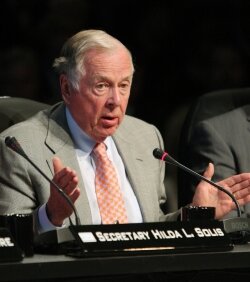Not so slim: Cough up big bucks to have influence
If you donated $3 million to your alma mater, what would you expect in return? Free basketball tickets? A plaque? A tree planted in your honor? In this economy, $3 million, while a nice gesture, isn’t enough to re-carpet a college library, much less buy much influence with a Board of Trustees.
So when Robert Burton demanded the University of Connecticut return his $3 million donation in January because he was unhappy with a new football coach (he has since let them keep it), it wasn’t just offensive, it was laughable.
Undoubtedly the most famous of all college football boosters is oilman T. Boone Pickens. In 2006, he donated a record $165 million to the Oklahoma State football program, promising to increase the sum to $300 million. It was the most blatant attempt to buy a college football program the NCAA had ever seen. And it worked.
Pickens got everything you would expect: a football stadium with his name on it, jobs for his friends, and, of course, tremendous influence over any and every decision regarding OSU athletics.
When the school needed a new athletic director, there was little doubt who would get the job.
“Boone didn't pick Mike [Holder]. He didn't try to pick Mike," says Oklahoma State President David Schmidly, explaining that he was the one who selected Pickens’ longtime quail-hunting buddy to make the climb from OSU men's golf coach to athletic director. "But why wouldn't you," said Schmidly, "want an athletic director that your top donor likes?”
Now if you’re T. Boone Pickens, that’s the kind of statement that makes you put your feet up and light a good cigar. Few people ever know that kind of self-satisfaction, a true blessing for the rest of us.
After I graduated, a very wealthy man (who shall remain nameless) purchased my private school. The school was renamed in his honor, the mascot and colors were changed, and the campus was much improved (air-conditioning!– after I graduated!) But Mr. Moneybags also had plans for the curriculum.
Foreign languages were to be eliminated altogether because the donor, in a self-satisfied way, claimed never to have needed anything but English to go from a poor boy in the tobacco fields of rural Virginia to a big-city businessman with his name on everything from a radio station to a major university’s business school.
He gave the money, so naturally it was, “Yes, Mr. So-and-So. Right away.” If not for the outcry from parents and teachers, Mr. So-and-So’s newly acquired academic institution would have sacrificed academics to accommodate his ego.
The world “entitlement” is bandied about a lot in sports, usually when referring to athletes. A March 2010 USA Today article, “Entitlement an Epidemic in Sports,” justifiably names Tiger Woods, Ben Roethlisberger, Gilbert Arenas, Babe Ruth, and Mickey Mantle as suffering from “heady” entitlement.
But nowhere in that article, nor in any other I could find, were America’s most powerful boosters mentioned: neither T. Boone Pickens nor Phil Knight (Oregon), Joe Jamail Jr. (University of Texas), Paul W. Bryant Jr. (Alabama) or UVA’s own Paul Tudor Jones II.
At least PTJ II had UVA name its new basketball arena for his father and not himself, but to what else did his $35 million donation entitle him? A new basketball coach? At Jones’ suggestion, Dave Leitao was hired the season before the John Paul Jones Arena opened. Three years later he was gone.
When colleges and universities trade influence for money, it’s a dangerous and counterproductive game. By 2008, Pickens’ $165 million to OSU was virtually gone (due to Pickens’ own mismanagement), and the university was in debt $300 million, having proceeded with the athletic renovations Pickens wanted.
It was the moment of truth for the booster. The far-reaching influence Pickens got for his money didn’t just put his football plans in jeopardy but Oklahoma State itself. So Pickens did the only thing he could do to retain his very entitled position– he donated more money.
And it wasn’t a paltry $3 million.
~
Juanita Giles lives on a farm in Charlotte County with her husband, son, and many dogs.
